Sumer
At the start of June, Mark and I got to trying out the Great Battles of History series. Or, I did, as Mark has played a little of it in the past. That said, we were trying Chariots of Fire, which apparently has somewhat different rules than the rest of the series. (I am disturbed by the fact that the series seems to have never picked up a single unified rule set, other than the variant Simple GBoH.) In fact, we were starting at the beginning, the battle of Sumer, ca. 2320 BCE.
This basically marks the transition from the old kingdom of Sumer to the kingdom of Akkad. There is, naturally, not a lot known of this period, and it’s obvious this is more of an excuse for an evenly-matched training scenario. Both sides get ten shock infantry, three light infantry (one of each of the three missile types), and one battle wagon (or battle car, as I’ve seen them elsewhere), and one heroic leader. The last is the only real difference between the two, with Sargon (the historical winner, and soon ‘the Great’) being one better than Lugal-zagessi in all ratings.
The map is flat and featureless, under the presumption that the battle would have taken place away from all the valuable irrigation infrastructure (I really doubt that, but again, training scenario…). We used the standard setup (you can figure out your own) given in the rulebook. So the first few turns consists of the two sides advancing on each other across an empty plain….
I had the Sumerians, and edged constantly to my left as we advanced, with the hope of being able to wrap around his flank. It’s technically a chit draw system, but there’s only one formation on each side in this small scenario, and an initiative roll means one person gets to choose what the first chit of the turn will be. However, there’s still four chits, as each side gets a “momentum” chit, where they have a chance to make a particular wing go again. Overall, the wrinkles to a regular chit draw system are nice, though it feels a bit odd in this extreme case.
Both of us were somewhat nervously edging up as we got into range of each other. I got a double move at the start of turn 3 (tied initiative, drew my momentum, which was successful, followed by my main wing chit; we did not catch the double-move cohesion penalty at this time) and moved about half of my line into contact with the Akkadians, with my right flank refused.
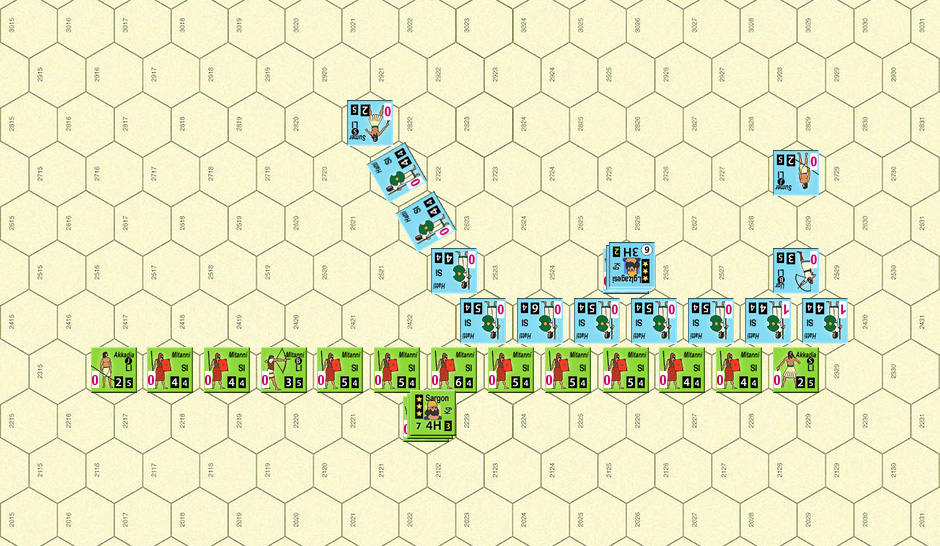
Shock combat took some time to figure out as the rules are muddled in important places, and it operates differently enough from normal expectations that this is a big problem. That said, it’s also got nice ideas. Every step of combat is done across all combat in the turn before going on to the next step, so that a combat between two lines of troops will act more like that. Unfortunately, the ‘pre-combat’ checks are not spelled out in the sequence of play, so you can’t rely on that, and that’s where some really important things happen.
When a new shock combat starts, the defender has to make a check against his troop quality, and if it fails he takes cohesion hits equal to how much he missed it by. At low troop quality (which light infantry usually has), this can easily cause the unit to rout before combat. Mark had anchored the end of his line with his slingers who had done a hit each to two units as they came in, and they immediately fled. None of the shock infantry routed, but two of his were heavily shaken going into combat. The standard combat result is for each side to take two cohesion hits, so those two hit their rout level, as did the unit on the end of the line, which I’d doubled-teamed for a 2/4 result. All three merely routed, ending up next to Sargon. (The action, or lack thereof, of routing is an understandable simplification, but does feel like teleporting units.)
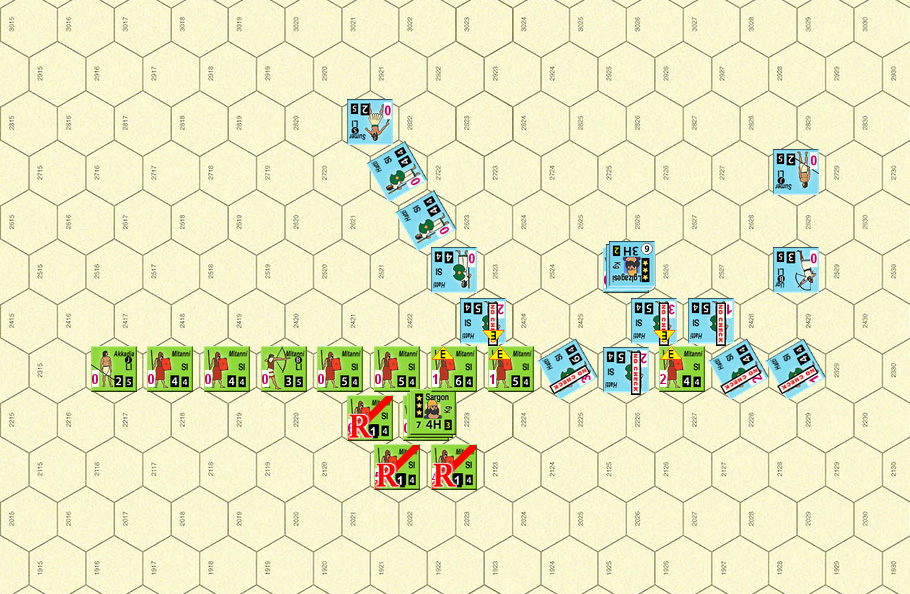
I then managed to successfully trump Mark’s main activation. That’s the last wrinkle in the chit pull system, where you can try to replace the enemy’s activation with one of your own. It takes a command roll, and if you fail, the enemy gets a second chance at his momentum chit. It’s a nice wrinkle, and I think it’ll feel better in bigger battles. This let me surge around the broken parts of the line, with Lugal getting in behind the line to shoot up one of the engaged shock infantry (which is a mistake, you can’t attack engaged units, even from behind).
The other pre-combat check is if a unit already in contact but not engaged (as opposed to moving into contact) will actually participate in combat. I got to one routed unit which immediately fled the field, and two more routed, one fleeing the field entirely.
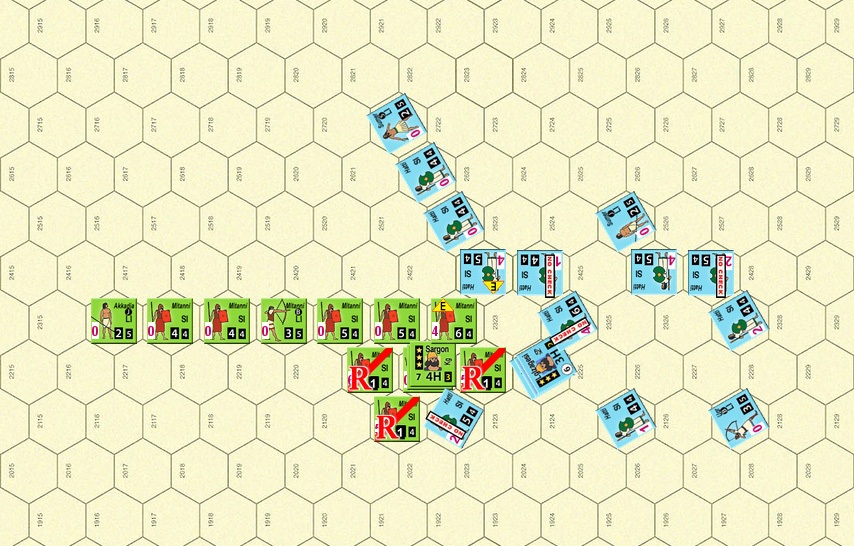
Mark successfully got his momentum after that, and tried a rally activation, which didn’t go so well as expected, as only routed units not adjacent to an enemy can rally, and of the three, that was true for one of them, who didn’t pass his roll. Everything else is considered out of command for that action, which let Mark shift his remaining line to face my refused flank, but he couldn’t move into contact. The one pair of engaged units got a 2/2 result in shock combat, causing my SI to rout while his was just shy of it (thanks to both hitting their limit, and me being over by more).
This ended the turn with the Akkadians at 10 of 20 rout points, and me, so far, at 0.
Mark got the initiative for turn 4, and put his infantry in motion. Mark maneuvered to patch his right a bit, and brought what was left of his main line into contact. Mark’s bow unit managed no more than low ammo while trying to drive off my SI behind his line, and my slingers did a hit to his javaliners while running out of ammo in reaction.
I rolled horribly for the defense check, with my slingers routing, and all four SI that were being attacked taking at least one hit. My flank ceased to exist with one unit fleeing, and the rest routing, and the forward unit that had gotten around the back also routed.
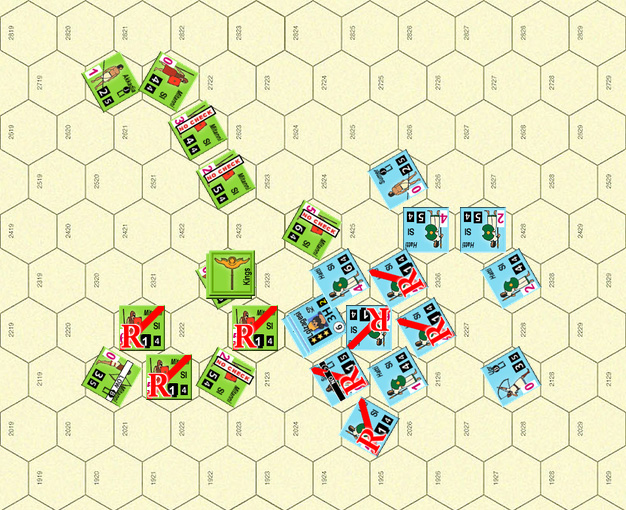
I failed on momentum, and took a chance to try and trump Mark’s momentum chit since whoever moved next would likely clean up the opposing side. Naturally, I failed (well, it was a 40% chance).
Mark got his momentum, and assembled a new, if shaken, line. This time, my untouched battle wagon unit routed as he came in (rolled a 9, but had nowhere to go as the banner was right there). The results would have been bad enough normally, but Mark was able to take my king’s banner, and all the routed units fled, leaving me a handful of effectives, and Mark re-drew his momentum and got it.
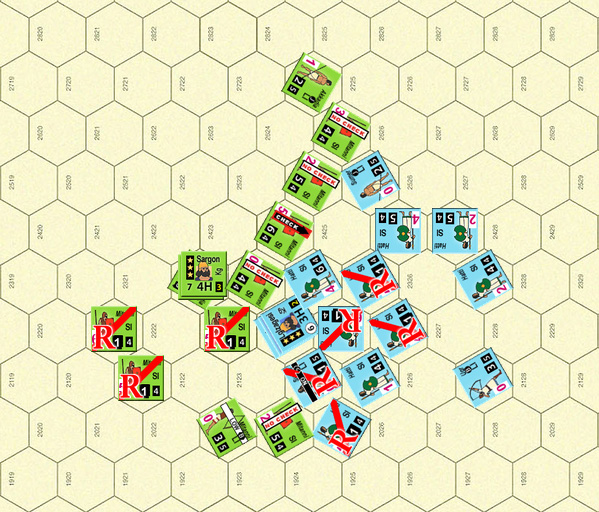
Afterword
We actually called it there with his momentum and my main chit to go. Technically victory is judged at the end of the turn, and the army that hits its rout limit first can still win if it can get the enemy even further above his limit in the rest of the turn. But, at this point, I was at 29 RP and Mark was at 10, and I didn’t see any way to make up the difference.
We made a number of mistakes that would have affected the battle greatly. I should have taken a lot of cohesion hits for my triple move on turn 3, which would have been a big deal. Mark maneuvered with Sargon as the fighting got near him, and moving the banner causes all nearby routed units to flee (a lesson we’re still wrestling with is finding a safe place for the banner to stay).
Mark had missed the defense roll going into shock combat in his solo plays, so his line breaking up from the impact of my guys charging into it was a surprise, and a nice reward to an attacker (if they can avoid too much cohesion damage from multiple moves on the way in…). This is a really nice feature of the CoF rules, and feels great.
The shock combat system as a whole needs another pass, writing-wise. Things are not said in important places, and then there’s the fact that each step of every combat is done in sequence across all combats, except when they aren’t. The real point of trouble is when ‘all’ units of both sides rout in a combat, one side doesn’t rout, at all. This is a good idea, but there’s mentions of breaking up into separate combats when one set obviously has nothing to do with what’s going on elsewhere. That also makes sense and seems a good idea, but there is zero guidance on what they were thinking when that was said.
If you have a couple SI fighting a couple enemy SI, and there’s a small gap between them? Does that count as two separate combats for the ‘everyone routs’ rule? What if one side has a continuous line, and the other doesn’t? What if the line broke up right now because of failed pre-battle defensive checks? I have no idea what was intended, and these questions come up constantly.

Discussion ¬